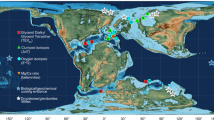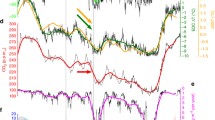Abstract
The stepwise cooling marks the long-time global climate change during the Cenozoic, particularly since the Oligocene/Eocene boundary. This climatic evolution has been punctuated by several warming such as the peak Cenozoic warmth at 52 Ma, the late Oligocene warming at ~25 Ma and the Mid-Miocene Climatic Optimum at 17–14 Ma. Concurring with the global temperature changes, the Asian paleoenvironment has been modulated by the global cooling and the tectonic uplift during the Cenozoic, but what have driven the global climatic changes remains unresolved. In this review paper, I hypothesize that a threshold CO2 level in combination with favorable orbital configuration, ocean circulation, enhanced ice albedo and possible roles of silicate mineral and basalt weathering together facilitated the development of glaciations in the Cenozoic and the past temperature change. The synchronous variations between Earth’s surface temperature and atmospheric CO2 level may indicate that the atmospheric CO2 content is the direct driving force for the global climatic cooling, but this hypothesis needs testing by using high-resolution geological record and paleoclimatic modeling.

Similar content being viewed by others
References
Zachos JC, Dickens GR, Zeebe RE (2008) An early Cenozoic perspective on greenhouse warming and carbon-cycle dynamics. Nature 451:279–283
Kennett JP (1977) Cenozoic evolution of Antarctic glaciation, the circum-Antarctic ocean and their impact on global paleoceanography. J Geophys Res 82:3843–3859
Flower BP, Kennett JP (1994) The Middle Miocene climatic transition: East Antarctic ice sheet development, deep ocean circulation and global carbon cycling. Palaeogeogr Palaeoclimatol Palaeoecol 108:537–555
Shevenell AE, Kennett JP, Lea DW (2004) Middle Miocene southern ocean cooling and Antarctic cryosphere expansion. Science 305:1766–1770
Moran K, Backman J, Brinkhuis H et al (2006) The Cenozoic palaeoenvironment of the Arctic Ocean. Nature 441:601–605
Lu HY, Guo ZT (2014) Evolution of the monsoon and dry climate in East Asia during late Cenozoic: a review. Sci China Earth Sci 57:70–79
Shackleton NJ, Backman J, Zimmerman H et al (1984) Oxygen isotope calibration of the onset of ice-rafting and history of glaciation in the North Atlantic region. Nature 307:620–623
Tian J (2013) Coherent variations of the obliquity components in global ice volume and ocean carbon reservoir over the past 5 Ma. Sci China Earth Sci 56:2160–2172
Clark PU, Archer D, Pollard D et al (2006) The middle Pleistocene transition: characteristics, mechanisms, and implications for long-term changes in atmospheric pCO2. Quat Sci Rev 25:3150–3184
Zeng L, Lu HY, Yi SW et al (2015) New magnetostratigraphic and pedostratigraphic investigations of loess deposits in NE China and their implications for regional environmental change during the Mid-Pleistocene climatic transition. J Quat Sci (in press)
Laskar J, Robutel P, Joutel F et al (2004) A long-term numerical solution for the insolation quantities of the Earth. Astron Astrophys 428:261–285
Beerling DJ, Royer DL (2011) Convergent Cenozoic CO2 history. Nat Geosci 4:418–420
Lu HY, Chang H, Guo ZT et al (2015) Continental collision, Qinghai-Tibetan Plateau growth and climate evolution—an introduction to Professor Peter Molnar’s scientific contribution (in Chinese). Sci Sin Terrae 45:770–779
DeConto RM, Pollard D (2003) Rapid Cenozoic glaciation of Antarctica triggered by declining atmospheric CO2. Nature 421:245–249
Pagani M, Huber M, Liu Z et al (2011) The role of carbon dioxide during the onset of Antarctic glaciation. Science 334:1261–1264
Coxall HK, Wilson PA, Pãlike H et al (2005) Rapid stepwise onset of Antarctic glaciation and deeper calcite compensation in the Pacific Ocean. Nature 433:53–57
Shao QL, Chen XY, Huang RX (2013) Effect of opening the Drake Passage on the oceanic general circulation: a box model study. Sci China Earth Sci 56:1588–1598
Molnar P, England P, Martinod J (1993) Mantle dynamics, the uplift of the Tibetan Plateau and the Indian monsoon. Rev Geophys 31:357–396
Pälike H, Lyle MW, Nishi H et al (2012) A Cenozoic record of the equatorial Pacific carbonate compensation depth. Nature 488:609–614
Woodruff F, Savin SM (1989) Miocene deepwater oceanography. Paleoceanography 4:87–140
Raymo ME, Ruddiman WF (1992) Tectonic forcing of late Cenozoic climate. Nature 359:117–122
Chen J, Li GJ (2011) Geochemical studies on the source region of Asian dust. Sci China Earth Sci 54:1279–1301
Li GJ, Elderfield H (2013) Evolution of carbon cycle over the past 100 million years. Geochim Cosmochim Acta 103:11–25
Wu HB, Guo ZT, Guiot J et al (2014) Elevation-induced climate change as a dominant factor causing the late Miocene C4 plant expansion in the Himalayan foreland. Global Change Biol 20:1461–1472
Fedorov AV, Brierley CM, Lawrence KT et al (2013) Patterns and mechanisms of early Pliocene warmth. Nature 496:43–49
Maslin MA, Li XS, Haug GH et al (1998) The contribution of orbital forcing to the progressive intensification of Northern Hemisphere glaciation. Quat Sci Rev 17:411–426
Haug GH, Ganopolski A, Sigman DM et al (2005) North Pacific seasonality and the glaciation of North America 2.7 million years ago. Nature 433:821–825
Nie JS, Stevens T, Song YG (2014) Pacific freshening drives Pliocene cooling and Asian monsoon intensification. Sci Rep 4:5474
Imbrie J, Berger A, Boyle EA et al (1993) On the structure and origin of major glaciation cycles .2. the 100,000-year cycle. Paleoceanography 8:699–735
Molnar P, Cronin TW (2015) Growth of the Maritime Continent and its possible contribution to recurring Ice Ages. Paleoceanography 30:196–225
Zeng MX, Song YG, An ZS et al (2014) Clay mineral records of the Erlangjian drill core sediments from the Lake Qinghai Basin, China. Sci China Earth Sci 57:1–14
Carrapa B, DeCelles PG, Wang X et al (2015) Tectono-climatic implications of Eocene Paratethys regression in the Tajik basin of central Asia. Earth Planet Sci Lett 424:168–178
Guo ZT, Ruddiman WF, Hao QZ et al (2002) Onset of Asian desertification by 22 Myr ago inferred from loess deposits in China. Nature 416:159–163
Guo ZT, Sun B, Zhang ZS et al (2008) A major reorganization of Asian climate by the early Miocene. Clim Past 4:153–174
Torres MA, West AJ, Li GJ (2014) Sulphide oxidation and carbonate dissolution as a source of CO2 over geological timescales. Nature 507:346–349
Acknowledgments
I thank the Editorial Board and Dr. Jianjing Wei for inviting me to write this paper; many thanks go to Prof. Zhengtang Guo for his valuable thoughts and helpful discussion. I appreciate the help of Prof. Yaoling Niu, Dr. Thomas Stevens and Dr. Mark Sweeney for correcting the English; thanks go to Yao Wang and Han Feng for help with drawing the Figure. This research is granted by the State Forestry Administration (201304325, 201404304) and Nanjing University.
Author information
Authors and Affiliations
Corresponding author
About this article
Cite this article
Lu, H. Driving force behind global cooling in the Cenozoic: an ongoing mystery. Sci. Bull. 60, 2091–2095 (2015). https://doi.org/10.1007/s11434-015-0973-y
Received:
Accepted:
Published:
Issue Date:
DOI: https://doi.org/10.1007/s11434-015-0973-y




